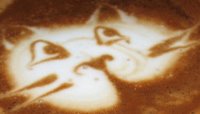Robert Parker, or Mother Parkers?
I encountered an interesting tasting note while hitting my usual stops online. It is a very accurate description of something I've drunk a lot over the past year. So I am quite pleased that the guy who wrote this really nailed it like he did.
Can you identify what he's drinking based on his description below? (I've edited it slightly, leaving out the key words so as to not give too much away.)
It feels richer, fuller and more viscous in your mouth. The acidity of the ------ is balanced; the tannins contribute shape, not sting.It's a tricky one to answer indeed. Give up? The kitty shown below knows the answer. Click on it to have it revealed.
The aroma is nuanced — with suggestions of scents like jasmine and orange — reflecting the pedigree of the ----- it’s made with, and the care and precision with which it was ------

Yup, the above is actually a tasting note for a cup of coffee, not a bottle of wine. The missing words were: coffee, beans, and brewed, respectively. You can find the article this excerpt came from at NYT Dining & Wine.
"It's coffee in a culinary context. It's not just a fix anymore." That's the good word from Café Grumpy, the artisanal coffeeshop from New York profiled in the article. Agreed!
They also serve artisanal coffee at Montreal's Caffè ArtJava, which is a restaurant café much closer to where I live. The ArtJava Macchiato made it onto my Top Five Things to Eat in Montreal.
Yes, of course something like coffee was one of my top tastes for The Foodblogger's Guide to the Globe. Drink it or eat it, this is serious stuff. When it's rooted in a real culinary craft, why shouldn't a great cup of joe get the respect it deserves?
 Clearly a lot of effort and precision goes into a good artisanal espresso. Just ask the baristas who make your artisanal latte. They typically favour roasts that are medium-dark (the "medium-rare" of of the coffee gourmand's world). J.D. Merget, owner of Oslo, which is another New York joint, explains this in the article: "It’s like grilling meat; if you char it but don’t burn it, you get to taste both the meat and the char. If you burn it all the way through, you’re just tasting char."
Clearly a lot of effort and precision goes into a good artisanal espresso. Just ask the baristas who make your artisanal latte. They typically favour roasts that are medium-dark (the "medium-rare" of of the coffee gourmand's world). J.D. Merget, owner of Oslo, which is another New York joint, explains this in the article: "It’s like grilling meat; if you char it but don’t burn it, you get to taste both the meat and the char. If you burn it all the way through, you’re just tasting char."And the feathery fern-like pattern the NYT reporter writes about is depicted in the design of the red ArtJava sugar packet in this photograph. If you watch this NYT video you can see how it all comes together.
The hypnotic milky topping created on top of your espresso shot is really quite an art. It's easy to be beguiled by it. But I also recognize that it's the craft behind these fantastic coffees that achieves the gastronomic success, and that is always the bottom line.
In the end, I guess no one should be surprised a quality espresso gets the wine tasting note treatment. After wine, there's no other part of my daily intake that I find is as enjoying or rewarding.
That said, I know there are some beer lovers who think their drink of choice is just as worthy of the tasting treatment. Perhaps writing a tasting note for beer compares more closely to one done for coffee. They're both "brews" and it's said that espresso's luscious crema can appreciated like the head on a stout beer.
I'll drink to that.







No comments:
Post a Comment